For the model year 2020 (MY20) Wayfinder, the wizzkids at New Age HQ have redesigned the front end of this traditional-style camper, rearranged and added space to internal cabinetry, and made big changes to the packages buyers can choose from. It cuts a familiar shape, it is the original and still popular style that started the craze of low drag, compact camping campers. Our test model is the 12ft Family, the smaller of the two-model range, with the 13ft Couples model its stablemate. You may think the 12 was smaller but it’s not. It's a double ender with acres of room internally thanks to its big width and tall roof. Both come available in two configurations, ours targeting the tracks. The 12ft moniker relates to the length of the cabin, sans A-frame, towball and bumper, whereas the overall length from bumper to towball drops in at 5.9m (19ft 4in), and 7.3m (23ft 11in) with beds extended.
ADVENTURER PACK
New Age offers the Wayfinder with two bundled option packs, the Comfort and the Adventurer, with Plus versions for each that add even more. The Comfort is aimed at holiday park travellers, with slipper spring suspension and is the base version — yet it still comes with key inclusions like a 100Ah battery, fridge, water tank and 9kg gas bottle to give you some off-grid capability.
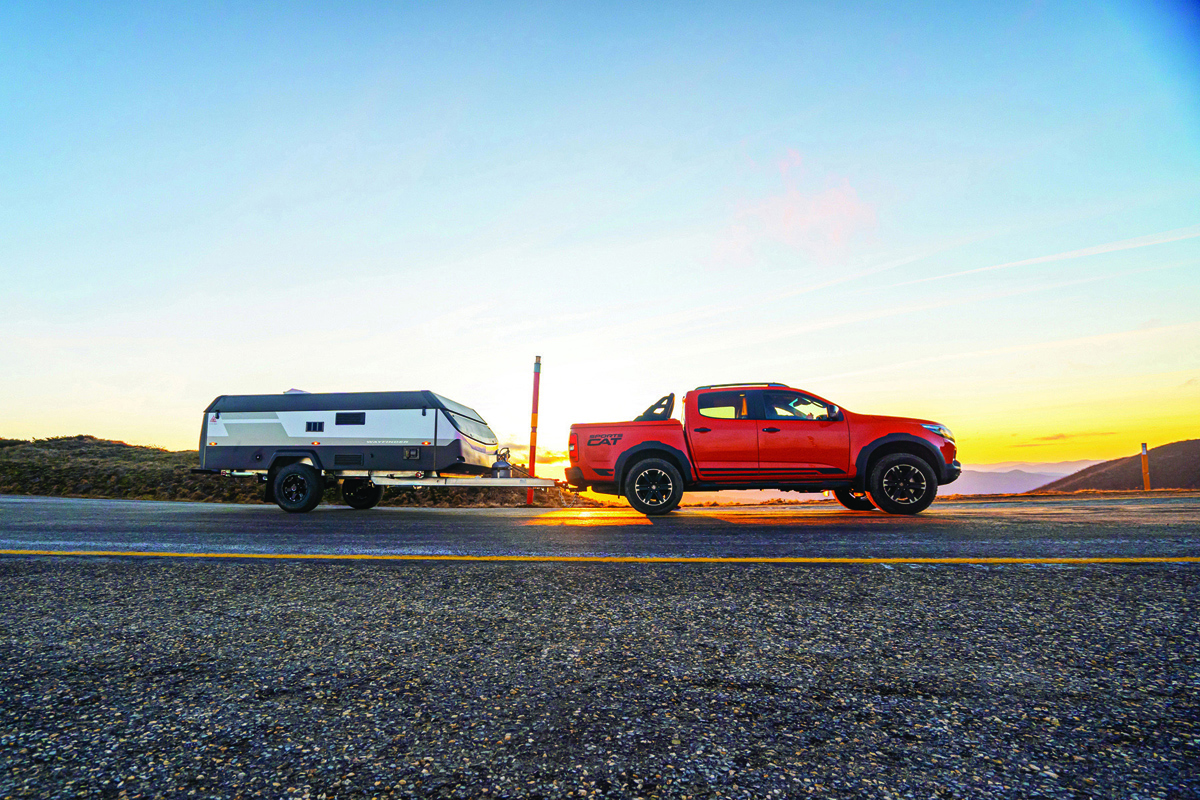


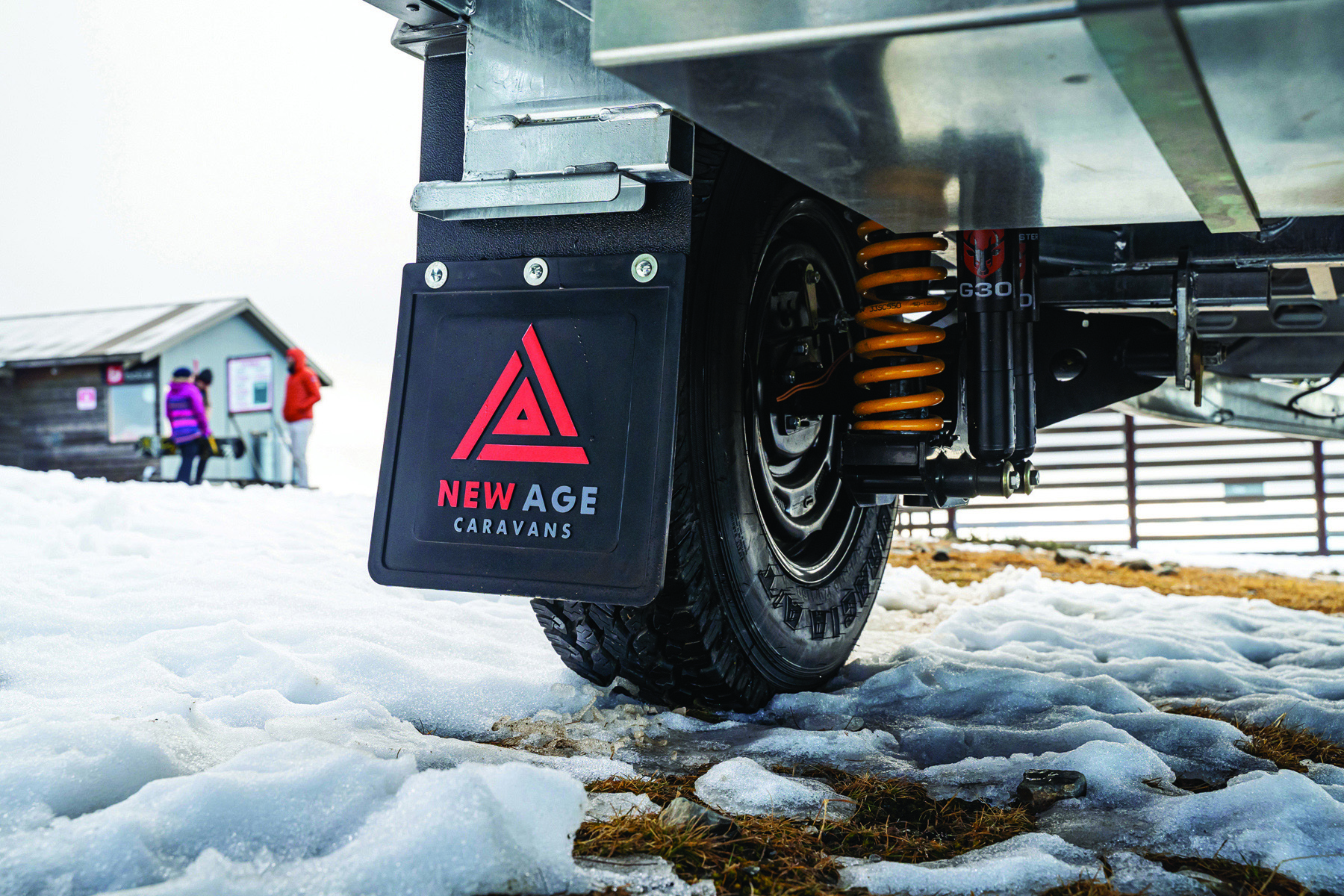
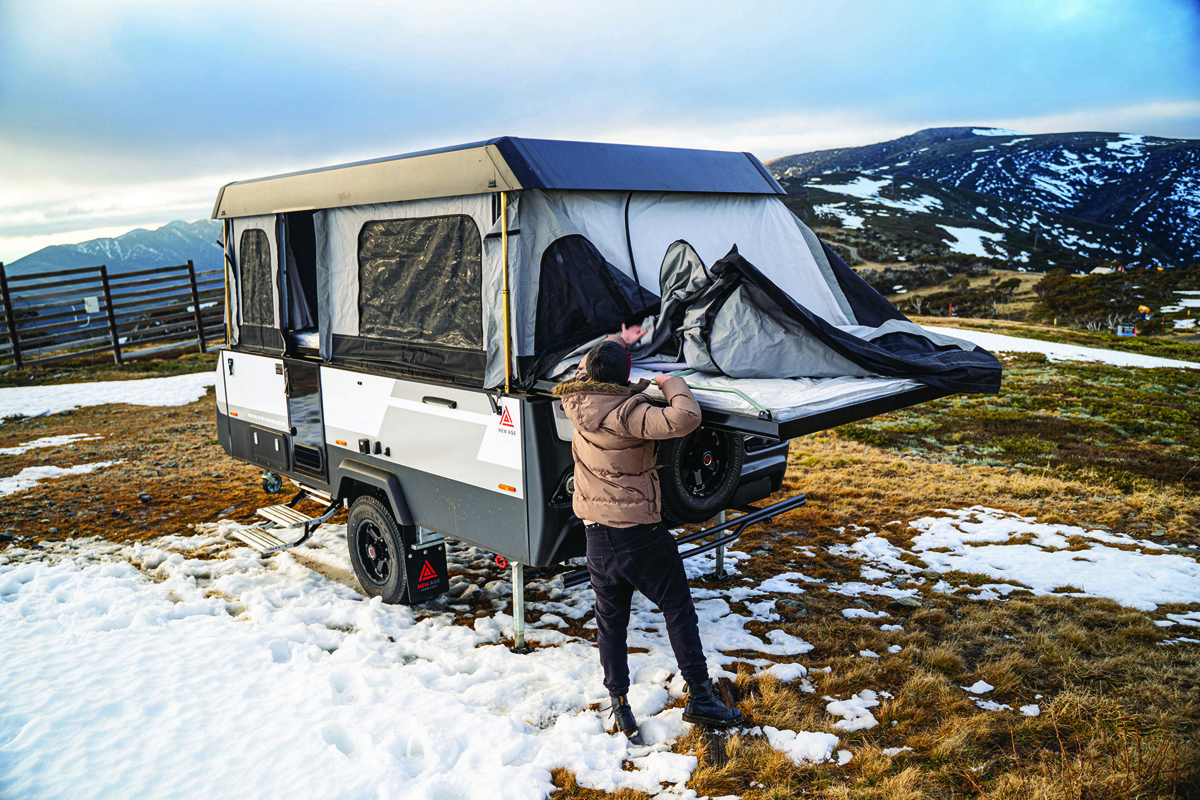
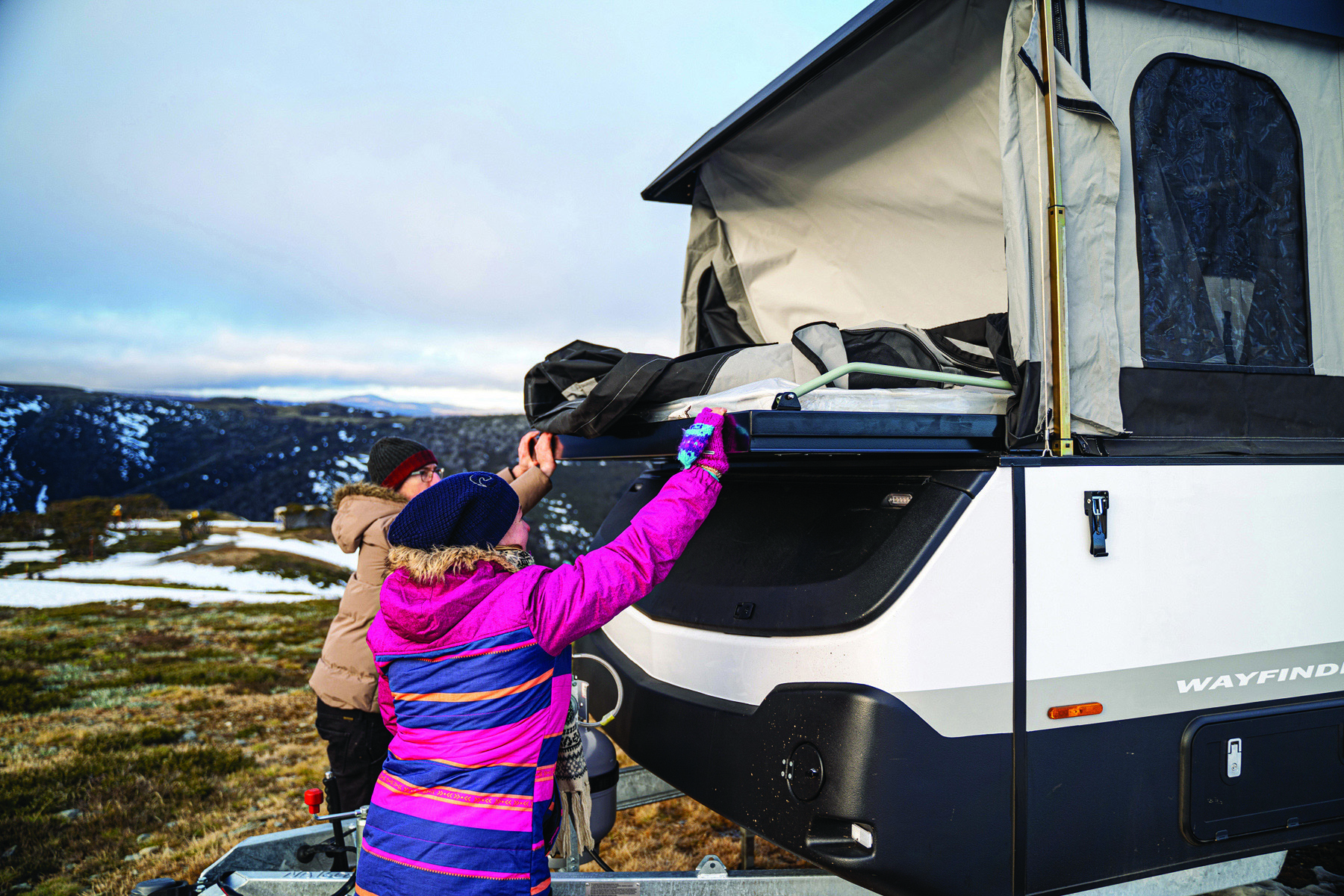
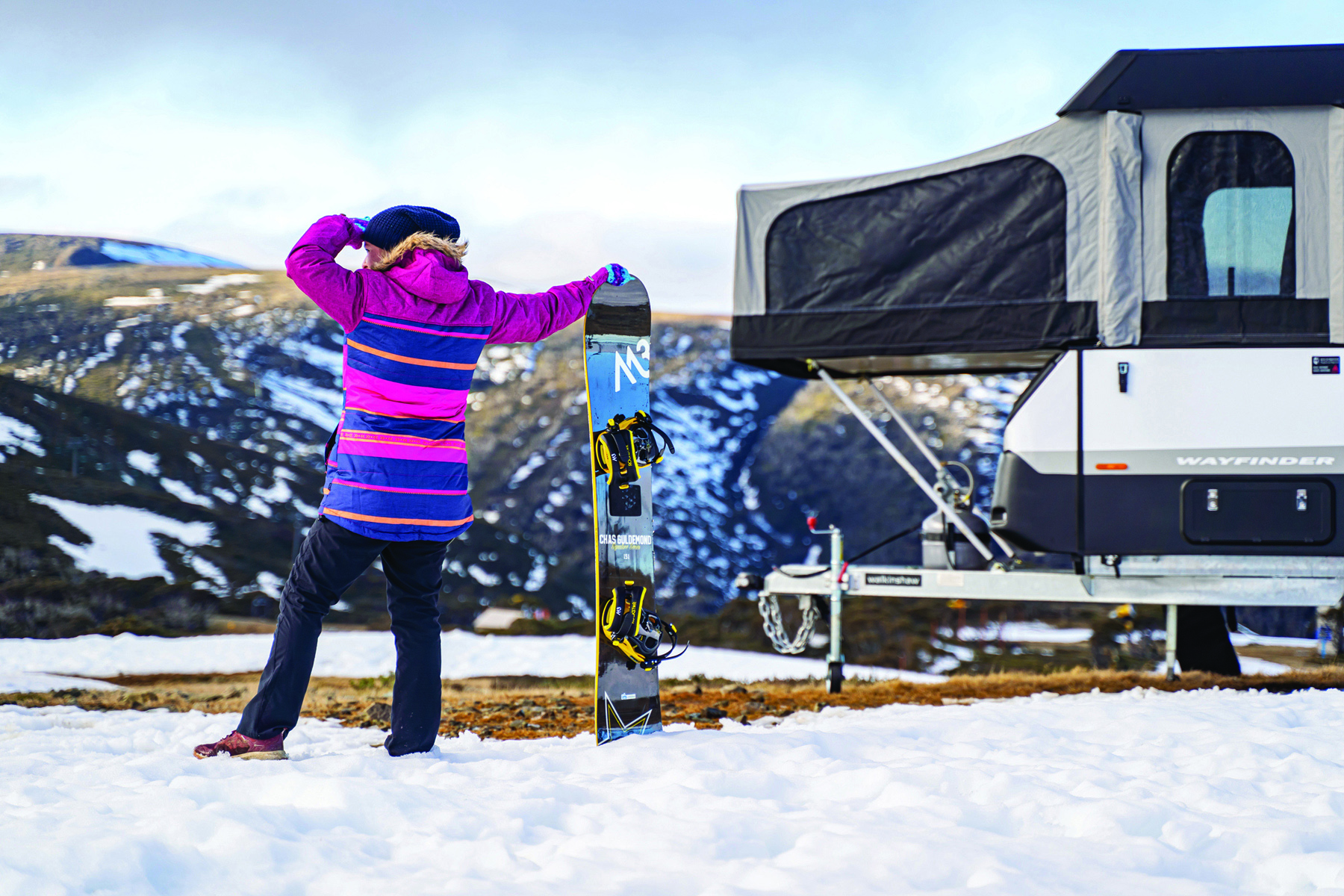
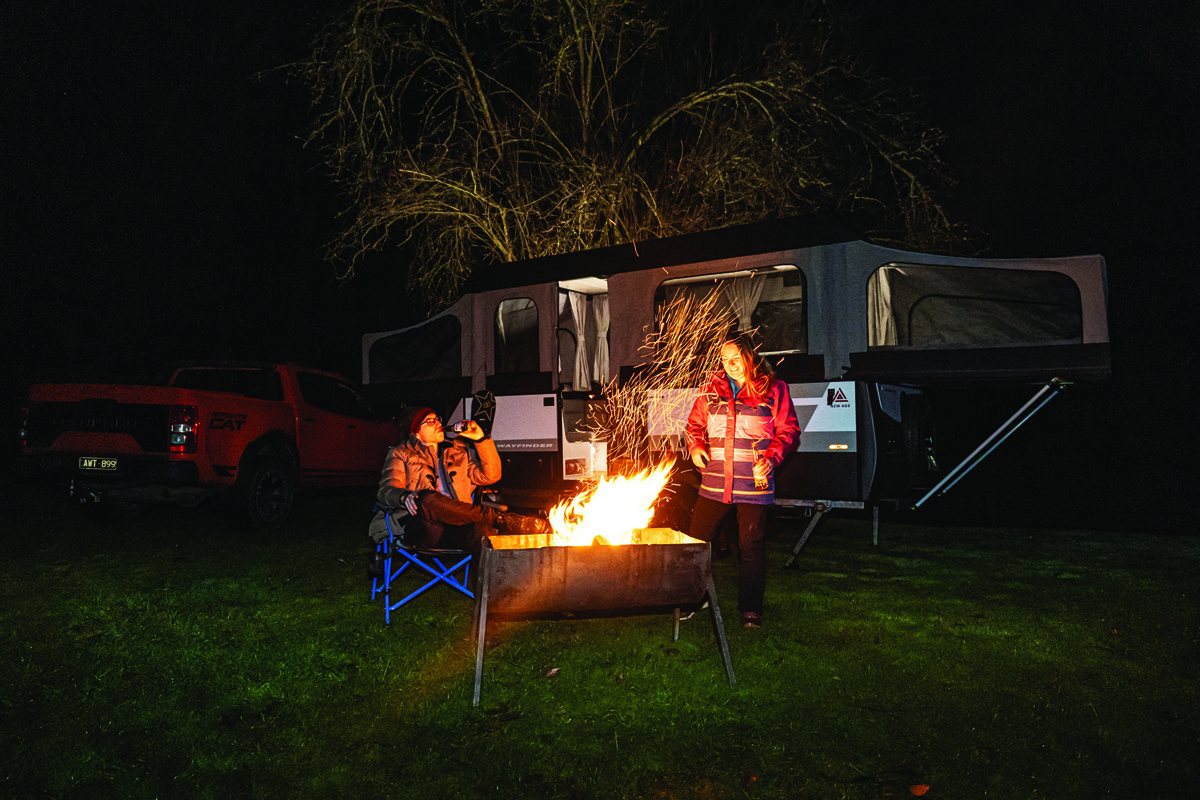
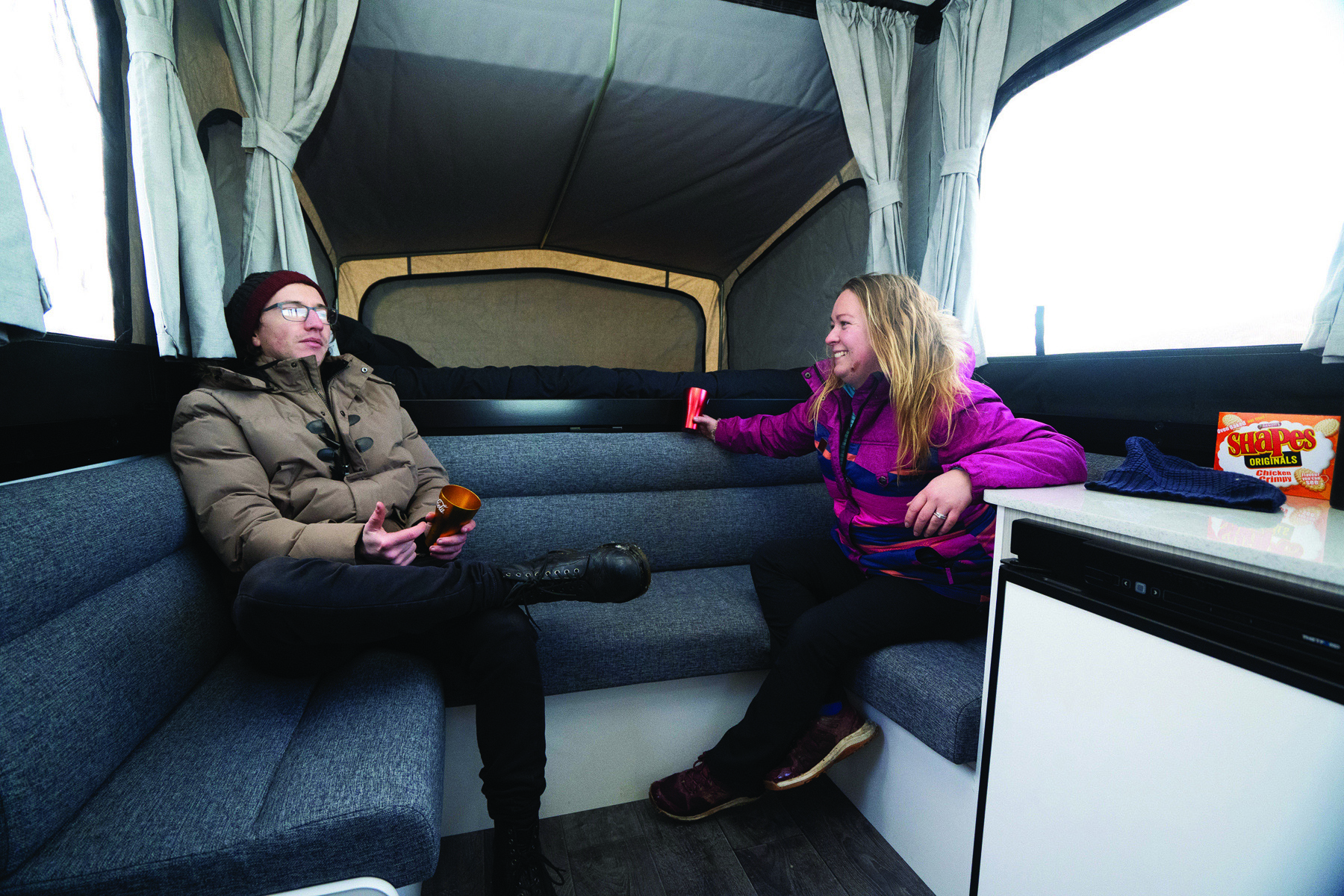
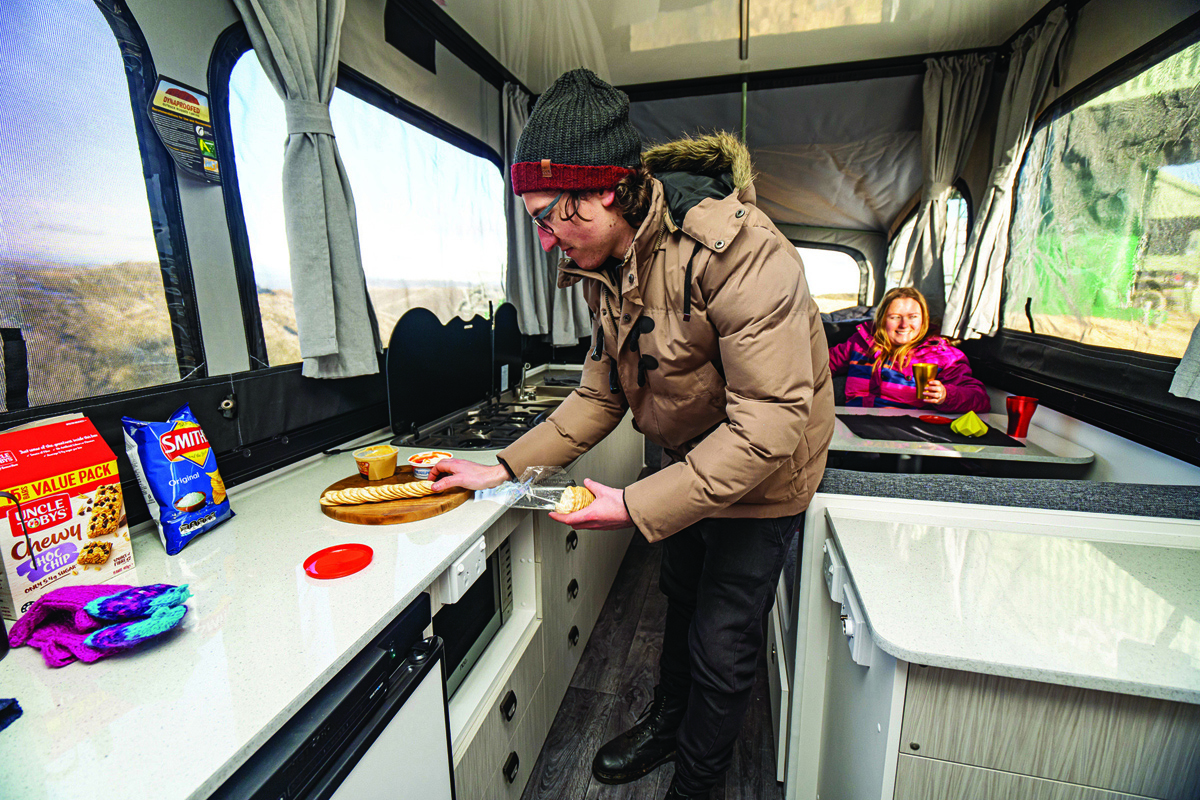
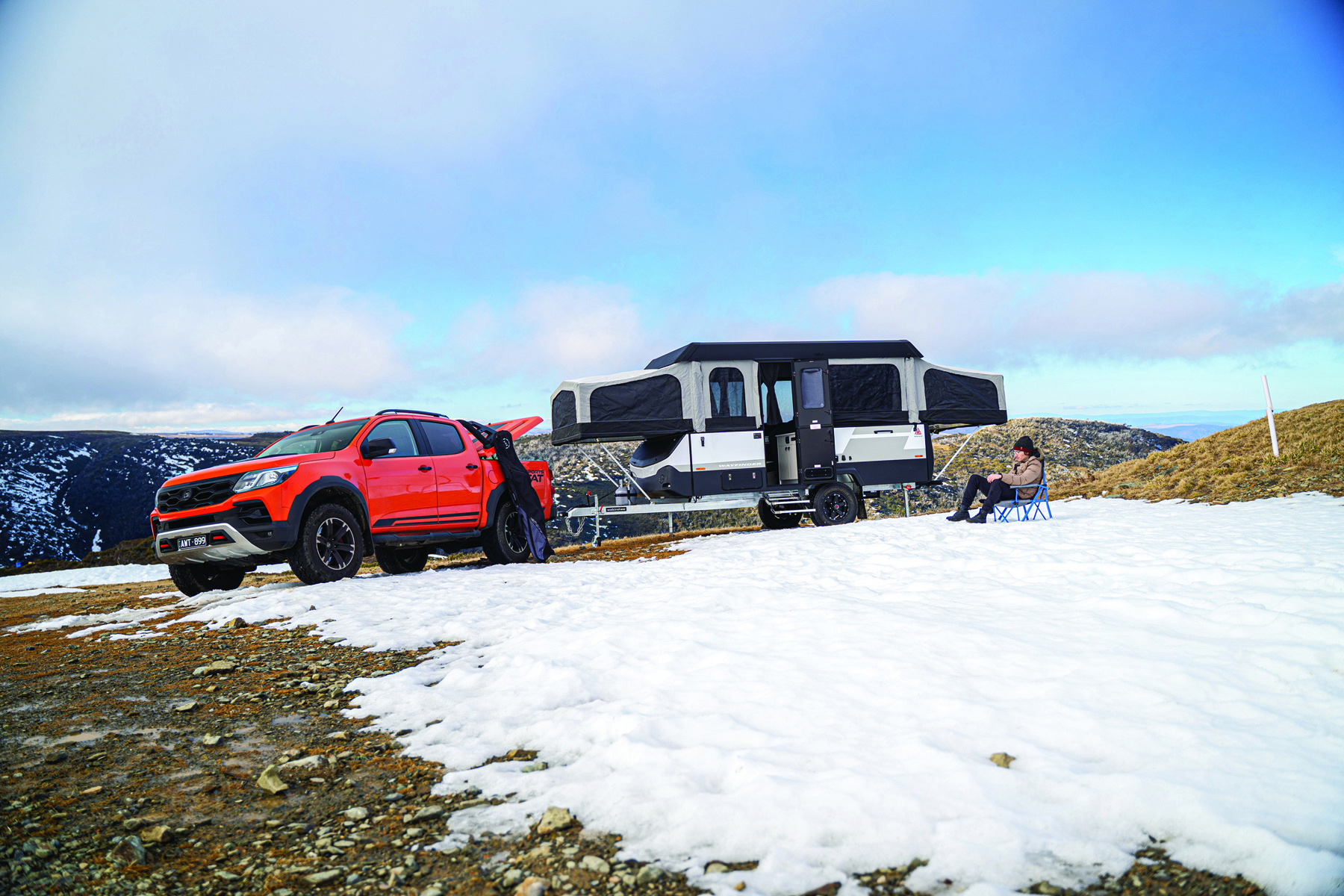
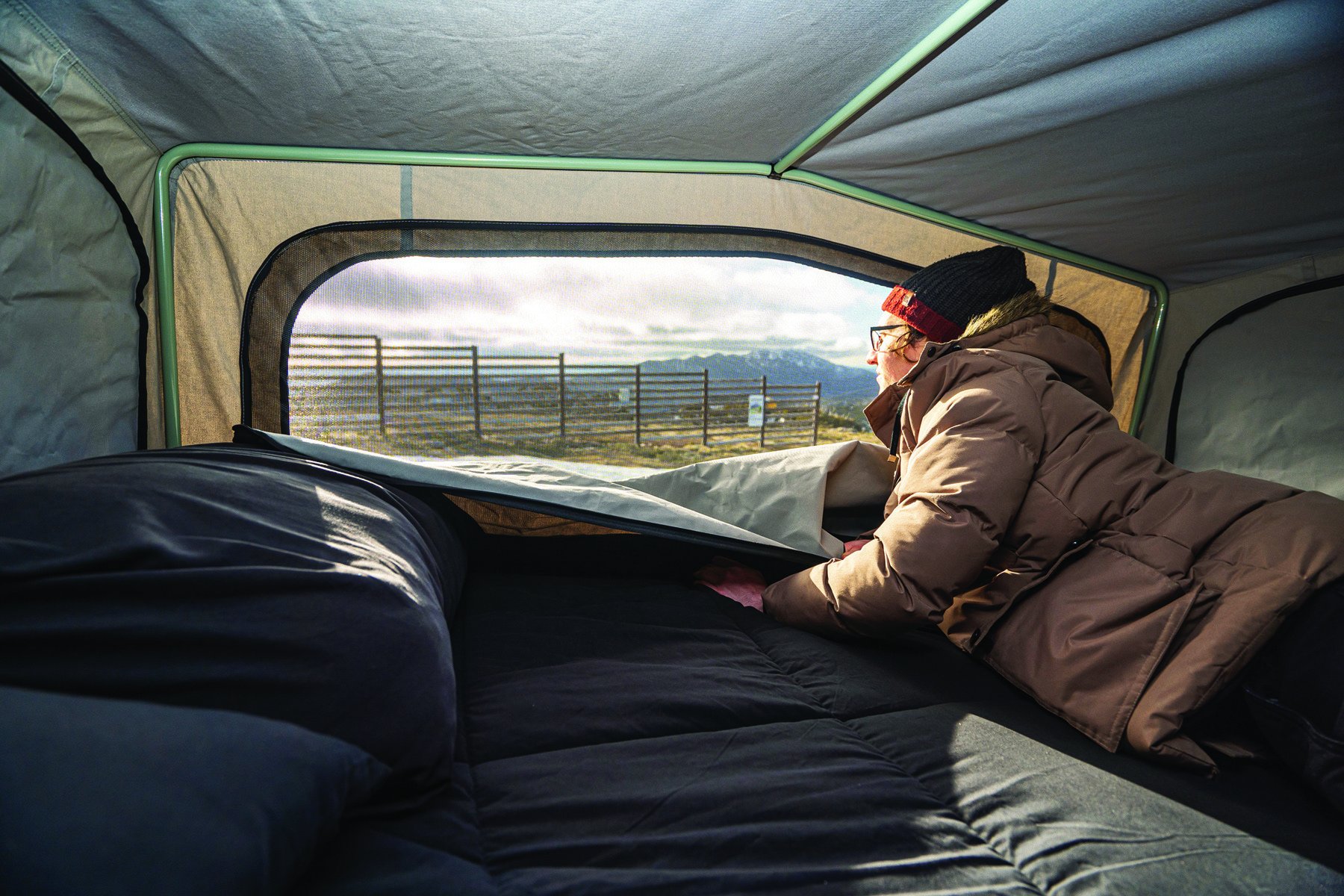
Tick the Plus pack and the factory will add on a solar panel, more water and gas capacity, plus sway control, a microwave and more. Our pick, the Adventurer, starts with the Comfort before swapping out running gear for Cruisemaster’s latest semi-offroad suspension, the CRS2, while keeping the fridge, water and power etc.
As the CRS2 is the main difference between the Comfort and Adventure packs, I’ll focus on that first. It’s a proper independent trailing arm suspension yet differs from Cruisemaster’s other offerings by not requiring a full cross member for support between the arms, which is a clever idea that reduces weight and should make installation easier as it is not hampered by set chassis widths. It utilises a round hinge to give a bit more flex where the arm meets the chassis.
Cruisemaster actually rates the CRS2 to 2500kg in single axle configurations so you know it's easily going to be tough enough for the 1880kg ATM New Age set for the Wayfinder.
The Adventure pack also includes coating of the lower surfaces for some light duty rock and tree protection, but I would still add on a proper stoneguard or Rock-Tamers to the tow-rig to keep the fibreglass front in tip-top shape.
CONSTRUCTION AND LAYOUT
One of the strengths of the New Age range comes from the automotive nous brought in when the brand was acquired by the Walkinshaw Group in late 2018. The sophistication in the engineering department is top-notch and is easily seen in the robotically welded chassis.
It is designed in-house using finite material analysis to get its strength-to-weight ratio perfect as well as guide the machine shop on weld lengths and locations. It is hot dipped for longevity and shows thoughtful design with cable and pipe management pretty good. The chassis is not notched for hoses etc, but nothing protrudes in ways that would have me scared when driving offroad.
Internally there's a focus on more and better storage throughout. There is ample under-sink storage for day-to-day gear, a good 93L fridge and areas like under the seats are usable for less-often-needed things, such as extra blankets for the overflow bed designed into the dinette.
The two main beds both feature innerspring mattresses and, although not overly thick, they felt good in our review. Ventilation around both is excellent with large zip-up blockouts of the same heavy duty, locally made canvas as the main walls, easy to access on all three sides of each bed plus there is a privacy curtain for each to separate them from the living space. Behind the blockout is a proper midge screen, tightly woven to keep the smallest biter out.
The living space is truly massive thanks to a high ceiling and the wide body. At 2.1m wide internally, this is one of the most spacious campers around and it really helps around the kitchen where no one is likely to bump into you when sneaking to the fridge or to plug a charger into one of the many powerpoints littered around the main dining area.
Oh yeah, it has a full internal kitchen unlike the bulk of campers on sale now. Yes, an awning can be thrown up over most external kitchens, but in the mozzie-infested northern coast or during the wet and windy southern states winters, you’ll appreciate the cosy confines of the Wayfinder's internal kitchen.
The cooktop is a three-burner so feeding a small army should be doable and the sink features a moulded drip tray for a drying rack and, tucked away under it, a full-size microwave — just like home.
Because it is tucked away in the wall cavities, a detail you won’t see but I think is clever is a move to an electrical loom designed specifically for the Wayfinder, with future upgrades like solar planned for. The BMPRO BP35M battery manager can charge the house battery up to 25A (plenty for the 100Ah AGB battery) and is ready to receive solar through a dedicated input.
Like all New Age products, the frame is meranti and the cladding Alucobond which is durable and hard to penetrate though it will show bush pinstripes, so be careful of the wide trailer on tight tracks.
THE SETUP
When you are in the outback, small is good as it allows access to remote camps on tight tracks. But, it adds complexity with folding bodies, canvas extensions and integrated awnings. The likes of a Complete Campsite or Conqueror can take an hour to set up. At the other end of the spectrum, a full-bodied caravan is easy, pull up, open the door and you’re done. A hybrid comes close with semi-hard walls, but both are bulky, giving them worse fuel-efficient towing plus the need for a keen eye around low branches and trees. Pop-tops fall between a hybrid and a folding camper in size and complexity, making them popular for first timers and people happy to take a little more setup time than a van in return for a camper that's easy to store and tow.
There are about seven key steps in setting up the Wayfinder 12ft Family. Start with dropping the legs, maybe three to five minutes with a drill or rattle gun (not recommended by the factory but one of my favourite camp-hacks). Next is the side clips holding the roof down while travelling and the wind-up process. Simple and obvious though depending on if it's a cold day (like ours) or hot, you might not appreciate the few minutes' workout you get. Then a surprise to me — the Wayfinder uses four individual lock-out poles that are velcroed to the legs to fully secure the roof. I’ve seen pop-tops that use a pin in the legs or an integrated hatcheting lock, so it was a surprise to see these in a camper from New Age — add on a couple of minutes to grab them from the front locker and get them on. Sliding out the ends is next, and I can happily say it was close to effortless with good plastic runners on the guides making it a one-person job. You’ll still need to tug on them evenly (from the centre helps) but they didn’t stick like some cheaper slide-outs I’ve sampled. This will take you a few minutes, maximum.
Head inside through the two-part door which needs to be unclipped from the ceiling and attached to the lower section (the lower section is permanently attached and weather-sealed to prevent dust getting in) and start tensioning the canvas through the alloy-poles.
The first time you do this will take a bit of time as there will be some slack from the factory to adjust out, but count on around three minutes again. Back outside and you need to velcro the sides of the canvas to the underside of the slide-outs and fit the support poles from the chassis up front and rear bumper on the back to the underside of each end.
The support poles are well thought out with a pin at one end and a Heim joint the other so you can easily identify which goes where. The ends add tension by screwing in opposite directions to each other to adjust the length easily once installed, and, as we found out after our second setup, the length should only need minor adjustments once done the first time.
We timed ourselves at about 30 minutes for the first setup and less than 20 for the second. If we were racing, I think we could have done it inside 15 minutes fully set up, which is a hell of a lot quicker than some of its competitors.
DRIVING AND VALUE
Towing a pop-top takes a bit more thought than a truly compact camper. They tend to be wider, and the Wayfinder has an external width of 2.15m. It was never daunting however as the tug on our test — the HSV Sportscat, the Holden Colorado based sports utility — was equally as wide. With a 3500kg tow rating, payload-friendly leaf springs in the rear and packing 147kW and 500Nm of torque in the auto-equipped model, it never flinched with the 1700kg tow weight we had. Brake control was by way of Redarc’s brilliant Tow Pro Elite-3, the brake controller of choice for almost all new vehicles. Set in proportional mode, it did exactly what was expected when winding down the mountain at day's end — it was barely noticeable.
Fuel efficiency was a tough one to report on as our shoot was not your normal drive. We went from 600m above sea level to 1700m over only 39 windy kilometres of driving between Harrietville and Mount Hotham in the Victorian High Country. The team from New Age reported around 17L per 100km driving on the drive up from Melbourne, which seems about right, so it's not too bad to tow. I know similar utes have shown better fuel consumption with smaller campers but like all things campers, it's a compromise. One thing that is not compromised though, is price.
Starting at a Maccas combo under $38,000 the Wayfinder 12Ft is at the high end of family campers, with the likes of Austrack, Blue Water and Mars all offering double-fold or forward-fold plus slide-outs for less. But, they are all much more complicated than the Wayfinder and do not feature a full internal kitchen. Jayco’s popular Swan OB (OB stands for Outback) starts about $1000 more and is the real target for the Wayfinder (with Adventure pack). A quick look at the specs and they are almost identical right down to the size of the fridge and battery type, so there is no denying these two compete.
TEAM SUPPORT
So we have a fundamentally simple yet well-equipped camper that is easy to set up and can swallow all of the family's gear and sleep them in their own beds. It's capable off the bitumen and is well made, but a lot of manufacturers offer all of that. What stands out for me with any New Age is support.
Our sister publication, Caravan World, did a bit of an expose on warranties, looking at what most major brands offered and compared that to the ACCC regulations on warranty. One of the standouts was New Age and, though a camper, the Wayfinder is no different.
Starting with a hitch to bumper three-year warranty, New Age adds on a 12-month assistance program which helps with simple things such as breakdowns, flat tyres, lost keys and more. It has some limitations in the cost of the callouts but for relatively new-to-camper buyers, this is a great show of support.
IN CONCLUSION
If you’re looking for your first camper and space is a priority, the Wayfinder should be on your list. It is simple and quick to set up, made with quality components and competitively priced with similar campers. The after-sales support is the icing on the cake for what should be a reliable and capable camper for most.
PRE-LOCKDOWN CHILLS
You might have noticed this review was shot in the snow. That was not done with modern trickery, we managed to get to the top of Mount Hotham a couple of days before the Victorian ski season was due to swing into action. Campers and other towed trailers are forbidden to enter the park during the season so we waited as long as we could to try to get some different images to what you’d expect.
You're probably wondering, is the Wayfinder winter-ready? Honestly, it’s not as well insulated as a hybrid and with the large volumes of canvas you would want to pack an extra doona or two, though it’s not out of the question with the internal kitchen perfect to boil the kettle for coffee.
SPECS
WEIGHTS AND MEASURES
Body/cabin length (sans A-frame, towball and rear bumper 3.6m (12ft)
Overall length (bumper to towball) 5.9m (19ft 4in)
Overall length (beds extended) 7.3m (23ft 11in)
Width 2.15m (7ft 1in)
Height 1.76m (5ft 9in)
Tare 1480kg
ATM 1880kg
Payload (calculated) 400kg
Ball weight 140kg
EXTERNAL
Frame Timber
Cladding Alucobond
Chassis Walkinshaw, hot-dipped galvanised
Suspension Cruisemaster CRS2
Coupling DO35A
Brakes 10in
Wheels 16in
Water 80L
Battery 100Ah AGM
Solar Optional
Air-conditioner Optional
Gas 1 x 9kg
Sway control Optional
INTERNAL
Cooking Three-burner stove, NCE 20L microwave
Fridge 93L Thetford three-way
Bathroom and hot water N/A
Hot water N/A
PRICE FROM
$37,990
OPTIONS FITTED
Adventurer Pack
MORE INFORMATION
New Age Caravans
29 Shirley Way, Epping VIC 3076
P: (03) 9305 1714
W: newagecaravans.com.au




